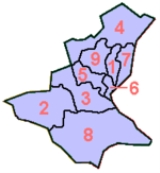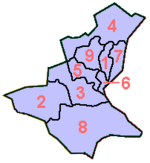
Novi Grad, Sarajevo
Encyclopedia

Sarajevo
Sarajevo |Bosnia]], surrounded by the Dinaric Alps and situated along the Miljacka River in the heart of Southeastern Europe and the Balkans....
in Bosnia and Herzegovina
Bosnia and Herzegovina
Bosnia and Herzegovina , sometimes called Bosnia-Herzegovina or simply Bosnia, is a country in Southern Europe, on the Balkan Peninsula. Bordered by Croatia to the north, west and south, Serbia to the east, and Montenegro to the southeast, Bosnia and Herzegovina is almost landlocked, except for the...
.
History
During the 1970s, Sarajevo was undergoing a rapid economicEconomics
Economics is the social science that analyzes the production, distribution, and consumption of goods and services. The term economics comes from the Ancient Greek from + , hence "rules of the house"...
and cultural
Culture
Culture is a term that has many different inter-related meanings. For example, in 1952, Alfred Kroeber and Clyde Kluckhohn compiled a list of 164 definitions of "culture" in Culture: A Critical Review of Concepts and Definitions...
development, with great expansion focused on population and industry
Industry
Industry refers to the production of an economic good or service within an economy.-Industrial sectors:There are four key industrial economic sectors: the primary sector, largely raw material extraction industries such as mining and farming; the secondary sector, involving refining, construction,...
. Novi Grad was a direct result of this period of heavy growth, in which many acres of previously unused land were transformed into Communist urban
Urban area
An urban area is characterized by higher population density and vast human features in comparison to areas surrounding it. Urban areas may be cities, towns or conurbations, but the term is not commonly extended to rural settlements such as villages and hamlets.Urban areas are created and further...
centres filled with apartment buildings. By the time the Novi Grad municipality was formally recognized, it had some 60,000 citizens, in 18 neighbourhoods.
According to the 1991 census
Census
A census is the procedure of systematically acquiring and recording information about the members of a given population. It is a regularly occurring and official count of a particular population. The term is used mostly in connection with national population and housing censuses; other common...
, the municipality of Novi Grad had 136,746 citizens. Four years of war
War
War is a state of organized, armed, and often prolonged conflict carried on between states, nations, or other parties typified by extreme aggression, social disruption, and usually high mortality. War should be understood as an actual, intentional and widespread armed conflict between political...
fare brought that number down tremendously. Some sections of Novi Grad were among the first to be occupied by the aggressors, while the city was repeatedly showered by mortar
Mortar (weapon)
A mortar is an indirect fire weapon that fires explosive projectiles known as bombs at low velocities, short ranges, and high-arcing ballistic trajectories. It is typically muzzle-loading and has a barrel length less than 15 times its caliber....
shells. Of the municipality's 33,517 residential buildings, 92% were damaged during the fighting.
Novi Grad has since made a fantastic recovery. Although many bullet holes and mortar shell impacts are visible throughout the municipality, it is overall healthy and functioning. As the most modern part of Sarajevo, Novi Grad is also ground to many new developments, such as the Bosmal City Center.
1971
111.811 total- Serbs - 45.806 (40,96%)
- Bosniaks - 37.147 (33,22%)
- Croats - 17.491 (15,64%)
- Yugoslavs - 5.798 (5,18%)
- Others - 5.569 (5,00%)
1991
136.616 total- Bosniaks - 69.430 (50,82%)
- Serbs - 37.591 (27,51%)
- Croats - 8.889 (6,50%)
- Yugoslavs - 15.580 (11,40%)
- Others - 5.126 (3,77%)
2002
According to the 2002 estimationEstimation
Estimation is the calculated approximation of a result which is usable even if input data may be incomplete or uncertain.In statistics,*estimation theory and estimator, for topics involving inferences about probability distributions...
, today the municipality of Novi Grad has 122,636 citizens, of which around 94% are Bosniaks, 2% Serbs and 4% Croats.
Communities and neighborhoods in Novi Grad
- Staro Hrasno
- Čengić Vila
- Otoka
- Švrakino selo I
- Švrakino selo II
- Švrakino selo III
- Aneks
- Alipašino poljeAlipašino poljeAlipašino Polje is a neighborhood in Sarajevo located in the municipality of Novi Grad. It is made of three neighborhoods Faza A, Faza B i Faza C, which include six local communities. It started building in 1974, and was finished in 1979. It's lowest buildings have 4 floors and highest one have 18...
-A Faza - Alipašino poljeAlipašino poljeAlipašino Polje is a neighborhood in Sarajevo located in the municipality of Novi Grad. It is made of three neighborhoods Faza A, Faza B i Faza C, which include six local communities. It started building in 1974, and was finished in 1979. It's lowest buildings have 4 floors and highest one have 18...
-B Faza - Alipašino poljeAlipašino poljeAlipašino Polje is a neighborhood in Sarajevo located in the municipality of Novi Grad. It is made of three neighborhoods Faza A, Faza B i Faza C, which include six local communities. It started building in 1974, and was finished in 1979. It's lowest buildings have 4 floors and highest one have 18...
-C Faza - Saraj Polje (Vojnicko Polje)
- Olimpijsko selo Mojmilo
- DobrinjaDobrinjaDobrinja is the most populous neighborhood of Sarajevo. It's part of the municipality of Novi Grad. In 1993 a mortar attack was conducted from Serb-held positions on a football game. 13 people died and over 130 were wounded....
A - DobrinjaDobrinjaDobrinja is the most populous neighborhood of Sarajevo. It's part of the municipality of Novi Grad. In 1993 a mortar attack was conducted from Serb-held positions on a football game. 13 people died and over 130 were wounded....
B - DobrinjaDobrinjaDobrinja is the most populous neighborhood of Sarajevo. It's part of the municipality of Novi Grad. In 1993 a mortar attack was conducted from Serb-held positions on a football game. 13 people died and over 130 were wounded....
C - DobrinjaDobrinjaDobrinja is the most populous neighborhood of Sarajevo. It's part of the municipality of Novi Grad. In 1993 a mortar attack was conducted from Serb-held positions on a football game. 13 people died and over 130 were wounded....
D - Buća potok
- Dolac
- Alipašin Most II
- Alipašin Most I
- Briješće
- Naselje heroja-Sokolje
- Dobroševići

